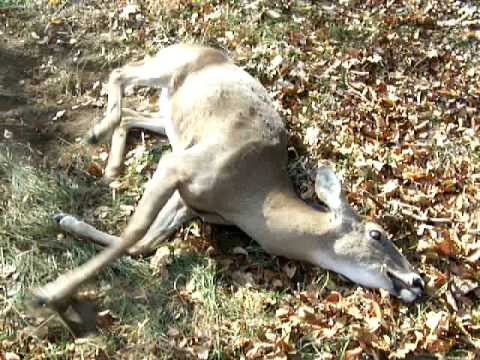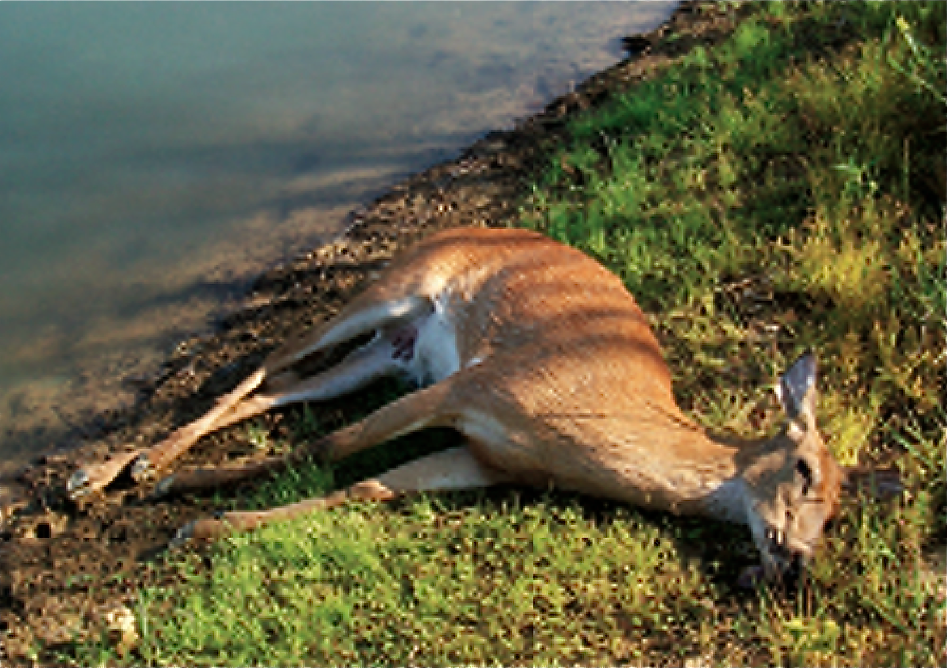
Epizootic hemorrhagic disease is one of the most important infectious diseases found in white-tailed deer, and can have a huge impact on populations and hunting success. What exactly is EHD and, more importantly, what can you do about it?
As you head out to the woods during late summer or early fall to prepare for deer season, you get chills from the mix of excitement and anticipation. Stale puddles of mud remain from the past week’s storm and the buzzing of summer pests, along with the babbling of a nearby creek, are almost deafening compared to the surrounding silence.
As you work your way through your favorite hardwood bottom, scanning the treetops for the telltale signs that this could be a good mast crop year, you catch the unmistakable odor of a dead animal. Across the creek you notice a partly decomposed doe that unfortunately won’t be around for the coming season. Instinctively, you scan the carcass and surrounding area for any telltale signs of what might have caused her death, but nothing stands out and so you continue on your preseason scouting expedition.
Thirty minutes later, you once again smell a dead animal and quickly locate a 21⁄2-year-old 8-pointer lying dead in the same bottom. What’s going on? How many deer carcasses are you going to find? Like the doe, this deer recently died, is fully intact, and has obviously died from something other than predation.
If this scenario seems familiar, you might have witnessed the wrath of epizootic hemorrhagic disease, also known as EHD. This disease is fairly common in the southern United States, but has also been detected elsewhere in North America, Asia, Africa and Australia. EHD is probably one of the most important infectious diseases of white-tailed deer and can have huge impacts on populations and your hunting success. So what is EHD? What causes it? Can you catch it? And what does it mean for your deer management program?
In 1955, tens of thousands of white-tailed deer died in Michigan and New Jersey from a mysterious disease that caused hemorrhages in vital organs. People were perplexed at the massive loss, and the disease was named EHD after some of its most characteristic pathological symptoms. Researchers later discovered that the disease was caused by a virus belonging to the genus Orbivirus. Since then, die-offs caused by EHD in white-tailed deer, pronghorns and mule deer have been documented annually around the country and even around the globe.
EHD is caused by either of two closely related viruses: epizootic hemorrhagic disease virus or blue- tongue virus (which also causes bluetongue disease). The viruses are related, and oftentimes symptoms are indistinguishable. Thus the term EHD or hemorrhagic disease is used to describe the symptoms when the specific virus is unknown.
How Does the Virus Spread? Contrary to popular belief, EHD cannot be spread from deer to deer via direct contact. Instead, this virus is transmitted primarily by biting midges, though the virus has also recently been detected in mosquitoes, suggesting they could be a vector for the virus as well. Biting midges are tiny biting flies often referred to as no see-ums, sand-gnats, sand flies, etc. These midges are tiny members of the fly family and more than 600 species have been described that feed on insects or other animals, yet only a handful of species feed on mammals and can transmit diseases.
Not much is known about which animals biting midges prefer to feed on, but they are frequently found on deer, livestock and other large mammals. When the midge feeds on the blood of an infected animal, it picks up the virus with the blood meal. Then, the next time it feeds (on another animal), it passes on the virus.

So how do you know if you are in a high-risk area for EHD? There are three things to keep in mind to help you understand the probability of EHD impacting your herd: location, season and symptoms. Geographic location can be a strong indicator of when and where to expect EHD. In Southern regions, EHD outbreaks occur much more frequently, while outbreaks are less frequent the farther you travel north, but tend to be more intense and cause a greater number of deaths.
Outbreaks have been found in 30 states, from Florida to the Dakotas in a wide swath that ranges from North Carolina to Nebraska. Annual outbreaks occur in Florida, with low rates of mortality. From the Carolinas to Louisiana, you can expect an outbreak every four to five years with moderate die-offs. As you go north, outbreaks occur every 10 to 20 years, but mortality rates can be significant. There are two well-known strains of EHD and five strains of bluetongue virus, and these strains of virus vary regionally. Less fatal strains tend to be found in regions where there are annual outbreaks, and the more fatal strains occur more in the North.
Season and weather patterns play a critical role in the occurrence of EHD. Outbreaks typically occur only when the weather is suitable for biting midges — during late summer or early fall. Midges are prevalent in warm, wet climates, primarily because they rely on standing water and warm temperatures to reproduce and propagate.
Therefore, the first frost of the year typically contributes to the mass die-offs of midge populations and significantly curbs the impact of EHD. So if you have healthy deer after the first frost of the season, they are likely to remain healthy and uninfected until the next summer. How the virus persists during these die-offs is unclear. But the virus can remain viable in infected animals for several weeks, so that might be the mechanism that leads to the virus surviving through the winter in Southeastern states, and might explain why it tends to be absent in Northern states.

Many infected deer do not initially show symptoms of illness; however, as the disease progresses animals begin to show early symptoms. One of the most obvious early signs of EHD is a lack of fear of humans. So if you are in the woods and notice skinny, weak, sickly looking deer that are unafraid of humans, it could be a sign of EHD. If you have an opportunity to get closer and notice heavy salivation, difficulty breathing and swollen areas around the head and neck, lesions in the mouth or detached hooves, those could all be signs of late-stage EHD infection.
Another early symptom is a high fever. While you can’t detect this from afar, infected deer with a fever are often found close to water sources (creeks, rivers, puddles, streams) cooling themselves off to bring the fever down. So seeing this behavior could be another sign. Water sources are also the ideal habitat for the midges that transmit this virus, so some scientists believe that deer going to a water source is also essential for driving the transmission cycle and leading to additional cases of EHD.
In some cases, depending on which strain of EHD is causing the infection, the disease might be fatal within a few days. In less virulent strains of EHD, deer often survive for longer periods of time, but continue to display the early symptoms. This eventually leads to loss of appetite and lameness, and some individu- als might even end up disabled for extended periods of time.
Three Forms of EHD While you might not be able to detect EHD symptoms from afar, there are typically three forms of EHD that can be classified based on symptoms. It is important to be aware of these symptoms if you are harvesting deer to make note of disease progression and intensity in a population.
No. 1: The peracute form of EHD — when deer only show swelling on the face, head, neck, tongue, and occasionally the lungs and eyelids.
No. 2: The acute form of EHD — when deer have the swelling seen in the peracute form, but also exhibit hemorrhages (lesions) or congestion in the heart, intestines or rumen. Sometimes you can also find ulcers on the dental pad, tongue and palate.
No. 3: The chronic form of EHD — which might include symptoms from Nos. 1 and 2, but is identified by hoof breaking or peeling of hoof walls. Sometimes ulceration of the rumen is also seen in this form. Deer with chronic lesions typically no longer have circulating virus, so while they are experiencing the worst form of the disease, these individuals are not likely to spread the virus to others in the population.
Should you be worried if you notice any of these symptoms? Yes and no. The good news is that deer mortality rates from EHD are low, usually ranging from 6 to 20 percent during outbreaks, depending on geographic location.
Outbreaks in the North tend to have greater mortality rates and occur less frequently, while outbreaks in the South occur annually and have lower mortality rates, because they have been previously exposed and have developed antibodies to the virus. This means that about 80 to 94 percent of infected deer actually get hemorrhagic disease, recover and survive, and the majority show absolutely no symptoms or problems after recovering, so there are no long-lasting impacts of EHD.
Typically, deer that are infected for the first time will show the above symptoms within days and will die shortly after. The virus can’t survive for more than 24 hours once the deer is dead, so dead deer do not serve as a source of the virus for the rest of the population.

How Many Deer Will Be Lost? The impact that EHD and blue- tongue has on deer populations is highly variable and can depend on deer immunity, habitat conditions, proximity to infected livestock, previous exposure to the virus, or the viral strain that deer are infected with. Outbreaks of EHD can result in a few deaths, or outbreaks that can wipe out more than half of the population; however, outbreaks generally result only in a small portion of the population dying, although the impression might be that mortality rates were much greater.
How Can You Confirm Which Virus Caused It? Distinguishing EHD virus from bluetongue virus based on symptoms is almost impossible, but there are some key features unique to both. The most common symptoms of EHD virus are lack of fear of humans, loss of appetite, swollen neck and head, and nasal discharge. Other key symptoms include a blue tongue from the lack of oxygen and swelling of the neck and head, salivation and breaking of the hooves. Broken hooves are a key feature that can be used to distinguish EHD from bluetongue virus.
Bluetongue virus is also transmitted by biting midges; however, this virus can also be passed on from mother to fetus causing stillbirth. Bluetongue virus is common in live- stock, and the symptoms of blue- tongue virus are similar to EHD virus in that deer often present with fever, salivation, nasal discharge, swelling of the face, lips and tongue (which can also turn blue due to lack of oxygen). Another key symptom of bluetongue virus is staggered respiration, foot lesions and lameness. In severely infected individuals, neck torsion (the head is in an abnormal position, either leaning to one side, forward or backward) is also common.
To confirm which virus caused EHD, a diagnostic test using fresh tissue is required. Since the viruses do not survive outside of an infected individual, fresh samples (whole blood, liver, lymph node, kidney, lung) are necessary for viral detection in diagnostic tests. These samples must be flash-frozen to avoid degradation and loss of the virus.
So if you suspect EHD and are interested in which virus caused the disease, it might be worth collecting a fresh sample, freezing it immediately, and sending it off to a State Diagnostic Lab. However, determination of the specific virus is purely an academic exercise, because EHD and bluetongue are considered one in the same from a deer management perspective. While disease ecologists, veterinarians and other animal health specialists require detailed knowledge of the virus, wild- life managers need only know that it was EHD or bluetongue.

Does EHD Pose Any Risk to Humans? Biting midges are not known to transmit disease to humans in the United States, but you should still practice caution when you come into contact with these biting insects. While there is no risk to humans, sometimes the bites from midges can trigger certain reactions in humans that can cause irritation. For example, bites from these insects are often found to inflict a burning sensation and small reddish welts at the bite site. In other cases, the bite wound can trigger a local allergic reaction.
Before you decide to toss out the meat you harvested on suspicion that it is infected, fret not. There is abso- lutely no evidence that eating meat from an EHD infected deer will do any harm. However, with chronic disease, some EHD deer develop abscesses or secondary infections (that would be visible in the meat), which might not be suitable for consumption.
What Can You Do? Although die-offs of whitetails due to hemorrhagic disease are certainly alarming, the impacts on deer herds, except in rare instances, are generally only mild to moderate. Unfortunately, there is not much that can be done from a management perspective in most cases. This is a naturally occur- ring disease that white-tailed deer have been coping with for thousands of years. The best thing you can do is monitor your herd throughout the year and adjust harvest prescriptions as needed. If EHD rears its head and you’re able to gain some insight into how many deer you’ve lost, you can adjust antlerless harvest quotas accordingly and allow your herd to recover without coping with the additional pressure of overharvest.
But, if you’re unaware of an EHD-driven decline in the herd and don’t account for the reduction in herd density when formulating a harvest plan, then you run the risk of reducing your herd density beyond desirable levels. If you’re unable to commit the time or resources to monitor- ing your herd, we recommend that you keep up to date with state and local reporting that might provide commentary on deer herd condition and health. You can expect that major EHD outbreaks will be reported in some form or fashion. But, as we’ve indicated, there really isn’t much you can do as a hunter/manager. If your herd gets hit, don’t fret, because the impacts are usually minor and short-lived.
As EHD season looms, we hope this information prepares you, helps take away the fear of EHD and equips you with the information to deal with an EHD outbreak near you.
— Dr. Sarah Zohdy is an assistant professor with a joint appointment between the School of Forestry and Wildlife Sciences and the College of Veterinary Medicine at Auburn University. She is a disease ecologist who conducts research both in the United States and internationally.
— Dr. Steve Ditchkoff is a professor in the School of Forestry and Wildlife Sciences at Auburn University. He manages the deer research program at Auburn and has been conducting research on white-tailed deer for 25 years.

